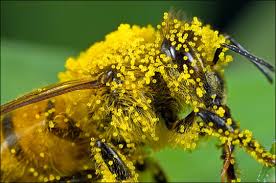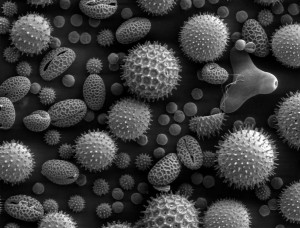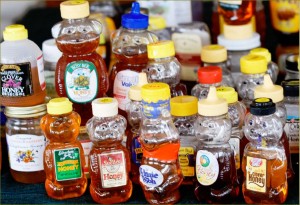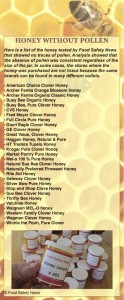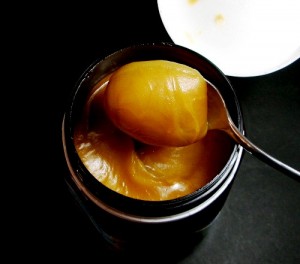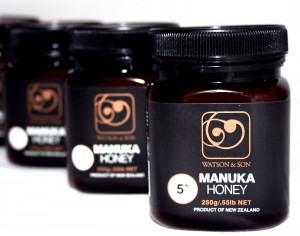Honey is an excellent natural product known for thousands of years and valued for its sweet flavor, flower aroma and healing properties. However, with the honey industry growth into multi-billion dollar business continues, fraudulent trend of replacing high quality honeys, especially its most expensive brands, by cheap surrogates is on the rise.
Pollen removal to conceal the honey origin
According to testing done exclusively for Food Safety News in 2011, more than three-fourths of the honey sold in U.S. grocery stores isn’t exactly what the bees produce. The results show that the pollen frequently has been filtered out of products labeled “honey.” The removal of these microscopic particles from deep within a flower would make the nectar flunk the quality standards set by most of the world’s food safety agencies.
The food safety divisions of the World Health Organization, the European Commission and dozens of others also have ruled that without pollen there is no way to determine whether the honey came from legitimate and safe sources.
In the U.S., the Food and Drug Administration says that any product that’s been ultra-filtered and no longer contains pollen isn’t honey. However, the FDA isn’t checking honey sold here to see if it contains pollen.
Ultra filtering is a high-tech procedure where honey is heated, sometimes watered down and then forced at high pressure through extremely small filters to remove pollen, which is the only foolproof sign identifying the source of the honey. It is a spin-off of a technique refined by the Chinese, who have illegally dumped tons of their honey – some containing illegal antibiotics – on the U.S. market for years.
Food Safety News decided to test honey sold in various outlets after its earlier investigation found U.S. groceries flooded with Indian honey banned in Europe as unsafe because of contamination with antibiotics, heavy metal and a total lack of pollen which prevented tracking its origin.
Vaughn Bryant, who is director of the Palynology Research Laboratory, found that among the containers of honey provided by Food Safety News:
•76 percent of samples bought at groceries had all the pollen removed, These were stores like TOP Food, Safeway, Giant Eagle, QFC, Kroger, Metro Market, Harris Teeter, A&P, Stop & Shop and King Soopers.
•100 percent of the honey sampled from drugstores like Walgreens, Rite-Aid and CVS Pharmacy had no pollen.
•77 percent of the honey sampled from big box stores like Costco, Sam’s Club, Walmart, Target and H-E-B had the pollen filtered out.
•100 percent of the honey packaged in the small individual service portions from Smucker, McDonald’s and KFC had the pollen removed.
Fake manuka honey
Manuka honey, an increasingly popular yet costly health supplement, is at the center of an international food fraud investigation amid evidence that big part of manuka honey is fake. Manukahoney, which sells for up to £45 for a 500g jar, has been praised by sports stars and celebrities such as Katherine Jenkins, the classical singer, Scarlett Johansson, the actress, and Novak Djokovic, the world No1 tennis player.
Manuka honey is produced by bees whose hives are placed near flowering wild manuka bushes that grow mostly on New Zealand’s North Island. Until 1981, when a New Zealand scientist found it had powerful anti-microbial properties, it was classed as a low-grade honey and used in cattle feed.
Tests carried out by the Food and Environment Research Agency (FERA), the scientific arm of Defra, the UK environment and food ministry, along with overseas studies suggest that much of the honey labelled as manuka has nothing to set it apart from ordinary honey – except the price. John Rawcliffe of the Unique Manuka Factor Honey Association (UMFHA), which represents New Zealand’s producers, said: “There is potentially huge fraud. There are higher and ever-increasing volumes of honey labelled as manuka that are not manuka. More manuka is sold in the UK alone than the total actually produced. The same applies to China, America and so on.”
In October 2011 FERA tested five brands of manuka honey sold in the UK. Only one showed the “non-peroxide” anti-microbial activity that is unique to genuine manuka honey. In further tests of 23 manuka-labelled honeys, 11 failed the non-peroxide test.
Bigger issue: Flood of fake honey from China
Chinese honey has long had a poor reputation in the U.S., where – in 2001 – the Federal Trade Commission imposed stiff import tariffs or taxes to stop the Chinese from flooding the marketplace with dirt-cheap, heavily subsidized honey, which was forcing American beekeepers out of business.
In February of 2013 it was broadly reported that ‘Project Honeygate’ led to five arrests and millions in fines. A Canadian man is among five people nabbed in “Project Honeygate,” a U.S. Department of Homeland Security undercover investigation into an alleged honey importing scheme. Five people and two companies are accused of flooding the market with cheaper honey from China and avoiding $180 million in duties, American officials said Wednesday.
The Chinese honey was declared as other commodities and shipped through other countries to the United States to avoid anti-dumping duties, Immigration and Customs Enforcement officials said.
Two of America’s biggest honey suppliers, Honey Solutions in Texas and Groeb Farms Inc. in Michigan, got caught in the “Honeygate” sting by the Immigrations and Customs Enforcement and admitted they facilitated the import of millions of dollars worth of illegal honey that was mislabeled. The sting focused on companies who avoided anti-dumping duties of about 200% on Chinese honey by first shipping the Chinese honey to middlemen in other countries, such as Vietnam and Indonesia, to disguise its origin what is called “transshipping.”
Groeb Farms agreed to pay $2 million in fines and Honey Solutions agreed to $1 million. Both have set up programs to ensure the honey they buy in the future comes from legitimate sources. Groeb also replaced its management.
“The more expensive the product, the more people are motivated to cheapen production,” Jill Clark, vice president of sales and marketing at Dutch Gold Honey (makers of the plastic honey bears), told the Modern Farmer.
Part of the problem is that there are few safeguards in place to ensure honey is legitimate. The U.S. Food and Drug Administration has standards for honey content, but rarely enforces them, Modern Farmer says. A researcher at Texas A&M found that 75% of the honeys he sampled didn’t contain pollen – the only way to determine its origin.
 FDA recently stated that food companies and other producers who add sweeteners to honey have to alert consumers by labeling their products as a “blend.” Only manufactures that do not add sugar, corn syrup or other sweeteners should label their products as pure “honey,” the FDA said in draft guidelines posted online.
FDA recently stated that food companies and other producers who add sweeteners to honey have to alert consumers by labeling their products as a “blend.” Only manufactures that do not add sugar, corn syrup or other sweeteners should label their products as pure “honey,” the FDA said in draft guidelines posted online.
In Europe, chief executive of Food Safety Authority of Ireland, Prof. Alan Reilly recently told the Irish Independent that honey and fish would be systematically surveyed in Ireland as part of new EU Food Fraud network attempts to tackle widespread organized crime in the European food chain. Honey from China has previously been mislabeled and passed off as Irish; and there have also been cases of “artificial honey” that is just sugar syrup going on sale in Europe, he said.

